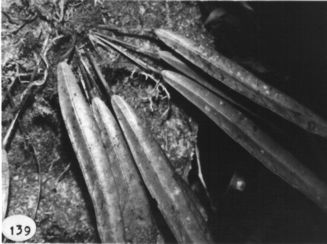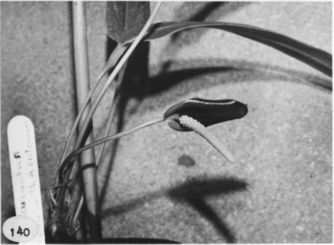





Anthurium protensum Schott,
Oesterr. Bot. Z. 8:,181.1858.
TYPE: Panama. Chiriquí: above San Felix along mining road, ca. 25 mi. off Pan-American Hwy. (above tumoffto Escopeta), ca. 1,500 m, Croat 33138 (MO 231113, ho-lotype; F, K, PMA, US, isotypes; Live at MO).
Usually epiphytic; stems 1.8 cm diam., roots directed downward; cataphylls 3.4-7 cm long, coriaceous, acuminate at apex (acumen apicu-late), drying tan (B & K Yellow 5/5), persisting intact, subsequently weathering into reticulate fibers.
LEAVES spreading; petioles 10-32 cm long, 3-4 mm diam., bluntly angled or rounded abax-ially, flattened to weakly sulcate adaxially; ge-niculum 1-1.5 cm long; blades oblong or narrowly oblanceolate, gradually acuminate at apex, obtuse to rounded at base, 19-51 cm long, 2.5-6 cm wide, broadest at middle and below; both surfaces semiglossy to glossy, the midrib bluntly raised above, sunken at apex; acutely raised below; primary lateral veins 7-11 per side, departing midrib at 50° angle, sunken in valleys above, raised below, weakly arching to collective vein, interprimary veins scarcely visible, sunken above, raised below, collective vein arising from base, 3-5 mm from margin, sunken above, raised below.
INFLORESCENCE erect to spreading, shorter than leaves; peduncle 13-38 cm long, 2-4 mm diam., pale green sometimes tinged with reddish violet, terete or 1-ribbed abaxially, one-half to 2 times longer than petioles; spathe green sometimes heavily tinged reddish violet (B & K Red-purple 3/10), ovate to broadly lanceolate, 4.5-6.5 cm long, 1.8-3 cm wide, caudate or short-acuminate at apex, rounded to subcordate at base, broadest at base, inserted at 70° angle on peduncle, curved over and hooding spadix, briefly de-current on peduncle; stipe 2-3 mm long, 2 mm diam., sometimes tinged red-violet; spadix weakly curved, lavender (B & K Purple 7/7.5) or pale green, 2-4 cm long, 5-6 mm diam. at base,3÷4 mm diam. at apex, the flowers rhombic to 4-lobed, 2-3 mm long, 2.3-2.8 mm wide, the sides jaggedly sigmoid, 4-5 flowers visible in the principal spiral, 5-8 flowers visible in the alternate spiral; tepals matte with dense papillae, lateral tepals 1-1.7 mm wide, the inner margin convex; pistils scarcely emergent, pale green, papillate; stigmas 0.3-0.4 mm long, elliptic, with small droplets briefly apparent before first stamens emerge, then moist with minute brush-like papillae; stamens emerging from the base, both lateral stamens emerged before opening, alternate stamens following quickly, pollen pale yellow fading to creamy white, defusing over tepals leaving brown, ellipsoid, slightly divaricate the-cae, anthers pale yellow, 4÷5 mm long, 9-10 mm wide, curved over edge of pistil.
INFRUCTESCENCE pendent to 7 cm long, 2.5 cm diam. (with berries exserted); berries bright orange, ovoid with a quadrangular beak, 8-9 mm long, 5-6 mm diam.; mesocarp pulpy; seeds 2, creamy white, ovoid-ellipsoid, 3-3.2 mm long, 2.2-2.3 mm diam., 1.5 mm thick, enveloped by a clear, sticky envelope, ca. 5 mm long, protruding further beyond the apex than the base. Figs. 139 and 140.
Anthurium protensum ranges from Costa Rica to Panama. Subspecies arcuatum is known only from western Panama in premontane rain forest at elevations of 1,200 to 2,000 m.
This is a member of section Pachyneurium and it is distinguished by its slender, short stem, its more or less oblong leaf blades that are usually spreading and weakly arched, and by its usually arched inflorescence (thus the name arcuatum). Also characteristic are its usually lavender, greenish white or purplish violet spadix and its ovate to broadly lanceolate, frequently purplish spathe that usually curves over and hoods the spadix.
The few cultivated collections of Anthurium protensum ssp. protensum and ssp. arcuatum are markedly different, but herbarium material is more difficult to separate. Subspecies protensum differs from ssp. arcuatum in having typically much larger leaf blades, rarely less than 50 cm long, with the primary lateral veins more numerous and less conspicuously sunken on upper surface (scarcely more prominently sunken than the interprimary veins). In addition, the lower midrib is convex and the plant typically has a lanceolate spathe, a much longer, narrowly tapered spadix, usually more than 9 cm long, and an infructescence usually 20-30 cm long. Subspecies protensum is also usually a pendent or near pendent plant, whereas ssp. arcuatum is erect.
Subspecies arcuatum rarely has leaf blades,more than 50 cm long, relatively fewer, sharply sunken primary lateral veins, an acutely raised lower midrib, a typically ovate spathe, with a spadix usually less than 5 cm long, and the in-fructescence less than 7 cm long.
 |
 |
Map of Mesoamerican specimens with coordinates
Panama Bocas del Toro: Fortuna Dam Area, 1200 m, 8.44N 82.17W, 11 March
1985, Croat & Grayum 60295 (MO).
Panama Bocas del Toro: Río Culebra, 1660 m,, 11 Feb. 1979, Hammel
6136 (MO).
Panama Bocas del Toro: Cerro Pate Macho,, , Hammel 6254 (MO).
Panama Bocas del Toro: Cerro Colorado, 1450-1480 m., 8.35N 81.50W,
6 Jul. 1988, Croat 69071 (B, CAS, F, MO, US).
Panama Chiriquí: 1100 m, 8.45N 82.13W, 8 Feb. 1984, H.W. Churchill,
G. de Nevers & H. Stockwell 4818 (MO).
Panama Chiriquí: 1100 m, 8.45N 82.13W, 8 Feb. 1984, H.W. Churchill,
G. de Nevers & H. Stockwell 4819 (MO).
Panama Chiriquí: 1170-1250 m, 8.45N 82.18W, 26 June 1987, Thomas B.
Croat 66839 (MO).
Panama Chiriquí: Cerro Colorado, 1200-1500 m,, 12 March 1976, Thomas
B. Croat 33138 (F, K, MO, PMA, US).
Panama Chiriquí: Fortuna Dam Area, 1100-1135 m,, 8 March 1985, Croat
& Grayum 60077 (B, CM, K, MO, PMA).
Panama Chiriquí: Cerro Colorado, 1500-1750 m,, 13 Aug. 1977, Folsom
et al. 4693 (MO).
Panama Chiriquí: Cerro Colorado, 2000 m,, 22 Nov. 1979, Thomas B. Croat
48461 (MO).
Panama Chiriquí: Cerro Colorado, 1200-1500 m,, 14 March 1976, Thomas
B. Croat 33369 (MO).
Panama Chiriquí: Cerro Colorado, 1200-1500 m,, 17 Aug. 1975, Mori &
Dressler 7770 (MO).
Panama Chiriquí: Cerro Colorado, 1610-1670 m,, 14 July 1976, Thomas
B. Croat 37111 (MO).
Panama Chiriquí: Cerro Colorado, 1610-1670 m,, , Thomas B. Croat 37132
(MO).
Panama Chiriquí: Fortuna Dam Area, 1200-1500 m, 8.47N 82.13W, 25 May
1984, Churchill 5306 (MO).
Panama Chiriquí: Boquete Region,, , Pittier 3062 (US).
Panama Chiriquí: Cerro Horqueta,, , Pittier 3160 (NY).
Panama Chiriquí: Cerro Horqueta,, , Pittier 3161 (US).
Panama Chiriquí: Cerro Punta,, , Wilbur et al. 13081 (DUKE).
Panama Chiriquí: Cerro Punta,, , Wilbur et al. 15235 (DUKE).
Panama Chiriquí: Cerro Punta,, , Wilbur et al. 15236 (DUKE).
Panama Chiriquí: Cerro Punta,, , Wilbur et al. 15252 (DUKE).
Panama Chiriquí: Cerro Punta,, , Wilbur et al. 15377 (DUKE).
Panama Chiriquí: Río Chiriquí Viejo, 1300-1900 m,, 1935,
Seibert 172 (K, MO, NY).
Panama Chiriquí: Boquete Region, 1930 m, 8.49N 82.28W, 19 Feb. 1986,
Hoover 1341 (MO).
Panama Chiriquí: 1630 m, 08.32N 81.46W, 30 March 1993, Thomas B. Croat
75043 (MO).
Panama CoclŽ: El Valle de Antón Region, 775 m, 8.36N 80.07W, 25 Mar.
1993, Thomas B. Croat 74790 (CM, MO).
Panama Veraguas: Santa Fe Region, 1330 m,, 22 Apr. 1980, Hammel &
Kress 8570 (MO).
Panama Veraguas: Santa Fe Region, 800-1350 m, 8.32N 81.7W, 5 June 1982,
Knapp & Dressler 5407 (MO).
Panama Veraguas: Santa Fe Region, 800-1400 m, 8.32N 81.7W, 20 March
1982, Knapp & Kress 4353 (MO).
Panama Veraguas: Santa Fe Region, 1200 m,, 19 June 1980, Folsom &
Mauseth 8344 (MO).
Panama Veraguas: Santa Fe Region, 1250-1350 m,, 30 Nov. 1979, Thomas
B. Croat 48964 (F,MO,US).
Panama Veraguas: Santa Fe Region, 1200-1450 m,, 14 May 1981, Sytsma
& Andersson 4587 (MO).